
Drag racing is a type of motor racing in which automobiles or motorcycles compete, usually two at a time, to be first to cross a set finish line. The race follows a short, straight course from a standing start over a measured distance, most commonly 1⁄4 mi, with a shorter, 1,000 ft distance becoming increasingly popular, as it has become the standard for Top Fuel dragsters and Funny Cars, where some major bracket races and other sanctioning bodies have adopted it as the standard. The 1⁄8 mi is also popular in some circles. Electronic timing and speed sensing systems have been used to record race results since the 1960s.

Acura is the luxury and performance division of Japanese automaker Honda, based primarily in North America. The brand was launched on March 27, 1986, marketing luxury and performance automobiles. Acura sells cars in the United States, Canada, Mexico, Panama, and Kuwait. The company has also previously sold cars in Mainland China, Hong Kong, Russia, and Ukraine. Plans to introduce Acura to the Japanese domestic market in the late 2000s did not eventuate due to the financial crisis of 2007–2008.

The Fast and the Furious is a 2001 action film directed by Rob Cohen from a screenplay by Gary Scott Thompson, Erik Bergquist, and David Ayer, based on the Vibe magazine article "Racer X" by Ken Li. The first installment in the Fast & Furious franchise, it stars Paul Walker, Vin Diesel, Michelle Rodriguez, Jordana Brewster, Rick Yune, Chad Lindberg, Johnny Strong, and Ted Levine. In the film, Dominic Toretto (Diesel) is a Los Angeles street racer suspected of masterminding a series of big-rig hijackings. When undercover cop Brian O'Conner (Walker) infiltrates Toretto's iconoclastic crew, he falls for Toretto's sister (Brewster) and must choose a side: the gang or the LAPD.
The National Electric Drag Racing Association (NEDRA) is a Special Chapter of the Electric Auto Association and exists to increase public awareness of electric vehicle (EV) performance. NEDRA has been working to encourage competition and advances in electric vehicle technology since 1997. NEDRA achieves this by organizing and sanctioning safe, silent, and exciting electric vehicle drag racing events. The business is based out of Houston, TX.

The Honda Civic is a series of automobiles manufactured by Honda since 1972. As of 2023, the Civic is positioned between the Honda Fit/City and Honda Accord in Honda's global passenger car line-up.
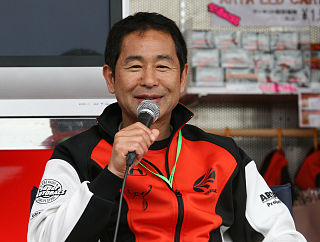
Keiichi Tsuchiya is a Japanese professional race car driver. He is known as the Drift King for his nontraditional use of drifting in non-drifting racing events and his role in popularizing drifting as a motorsport. In professional racing, he is a two-time 24 Hours of Le Mans class winner and the 2001 All Japan GT Championship runner-up. He is also known for touge driving.

The Nissan Violet is a model of car that appeared in Japan in 1973, and was exclusive to Japanese Nissan dealerships called Nissan Cherry Store as a larger companion to the Nissan Cherry.
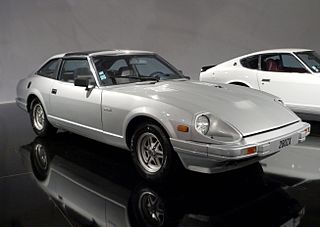
The Nissan S130 is a sports coupé produced by Nissan in Japan from 1978 until 1983. It was sold as the Datsun 280ZX, Nissan Fairlady Z and Nissan Fairlady 280Z, depending on the market. In Japan, it was exclusive to Nissan Bluebird Store locations. It was the second generation Z-car, replacing the Nissan Fairlady Z (S30) in late 1978. The 280ZX was the first time the "by Nissan" subscript was badged alongside the Datsun logo, along with Nissan trucks. The 280ZX was Motor Trend's import car of the year for 1979. The 280ZX was replaced by the Nissan 300ZX in 1984.

The Nissan S30, sold in Japan as the Nissan Fairlady Z and in other markets as the Datsun 240Z, then later as the 260Z and 280Z, is a grand tourer produced by Nissan from 1969 until 1978. The S30 was conceived of by Yutaka Katayama, the President of Nissan Motor Corporation U.S.A., and designed by a team led by Yoshihiko Matsuo, the head of Nissan's Sports Car Styling Studio. It is the first car in Nissan's Z series of sports cars.

Need for Speed: Underground is a 2003 racing video game and the seventh installment in the Need for Speed series. It was developed by EA Black Box and published by Electronic Arts. Three different versions of the game were produced: one for consoles and Microsoft Windows, and another for the Game Boy Advance. An arcade version was additionally developed by Global VR and was published by Konami with assistance from Electronic Arts.
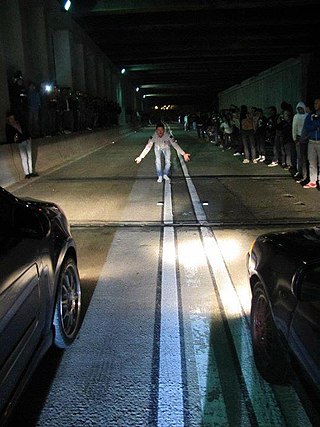
Street racing is typically an unsanctioned and illegal form of auto racing that occurs on a public road. Racing in the streets is considered an ancient hazard, as horse racing occurred on streets for centuries, and street racing in automobiles is likely as old as the automobile itself. It became especially prevalent during the heyday of hot rodding (1960s), muscle cars, Japanese imports (1990s) and sports cars (2000s). Since then, it continues to be both popular and hazardous, with deaths of bystanders, passengers, and drivers occurring every year. In the United States, modern street racing traces its roots back to Woodward Avenue, Michigan, in the 1960s when the three main Detroit-based American car companies were producing high-powered performance cars. Since a private racing venue was not always available, street races would be held illegally on public roads.
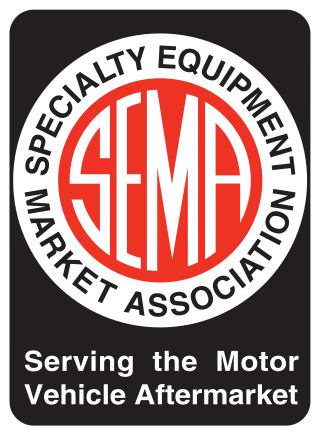
Specialty Equipment Market Association (SEMA) of the automobile aftermarket was formed in 1963 by Paul Schiefer, Roy Richter, Ed Iskenderian, Els Lohn, Willie Garner, Bob Hedman, Robert E. Wyman, John Bartlett, Phil Weiand Jr, Al Segal, Dean Moon, and Vic Edelbrock Jr. Now it consists of 6,383 companies worldwide, bringing together aftermarket manufacturers, original equipment manufacturers (OEM), media, car dealers, specialty equipment distributors, installers, retailers, and restoration specialists.
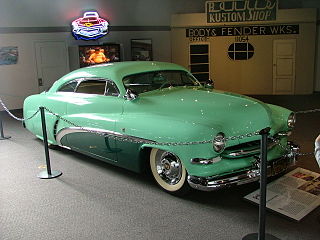
A custom car is a passenger vehicle that has been altered to either improve its performance, change its aesthetics, or a combination of both. Some automotive enthusiasts in the United States want to push "styling and performance a step beyond the showroom floor - to truly craft an automobile of one's own." A custom car in British according to Collins English Dictionary is built to the buyer's own specifications.

Megalopolis Expressway Trial is the original title of a series of six Japanese films, about illegal highway racing in the Shuto Expressway, released between 1988 and 1996. An English subtitled version of the film series was released on DVD in North America in 2004 due to commercial success of popular Hollywood films like The Fast and The Furious. A 4-disc re-release of the 2004 edition was made available in 2007, it was renamed Tokyo Speedway: The Complete Collection. Though also available in Hong Kong, the DVD edition was not released in Japan since the series is still banned and the last episode unreleased yet.

Zero4 Champ is a series of racing games created by Yutaka Kaminaga at Media Rings, which started in 1991 with the PC Engine title Zero4 Champ.

During its history the Toyota Supra has enjoyed considerable success in a variety of different motorsports.
Simpson Performance Products is an American motorsports parts supplier that manufactures safety products such as gloves, helmets, harness systems, driver's suits, head restraints, and shoes. It is marketed to racers ranging from participants at local track days to international Formula One and NASCAR teams. It was started by Bill Simpson as Simpson Drag Chutes.

NZ Performance Car is a monthly automobile magazine and website, and is the biggest selling automotive and men's lifestyle magazine in New Zealand.

The American Honda Motor Company, Inc. is the North American subsidiary of Japanese Honda Motor Company. Founded in 1959, the company combines product sales, service and coordinating functions of Honda in North America, and is responsible for distribution, marketing and sales of Honda and Acura brand automobiles, Honda Powersports products, Honda Power Equipment products, Honda Engines products, Honda Marine engines, and the HondaJet aircraft.

Ndubisi "Bisi" Ezerioha is a Nigerian-American engineer, professional race car driver, entrepreneur and engine builder. He is the current CEO and Chief Engineer for Bisimoto Engineering. Ezerioha is involved in import drag racing, and pilots a 2006 Honda Insight in the pro stock ranks of IDRA, IDRC and CMI series. A chemical engineer by training, and entering university at the age of 15, he was a pharmaceutical researcher for years before he decided to branch off. His automotive creations have appeared in numerous films, television shows, toys and video games.



















